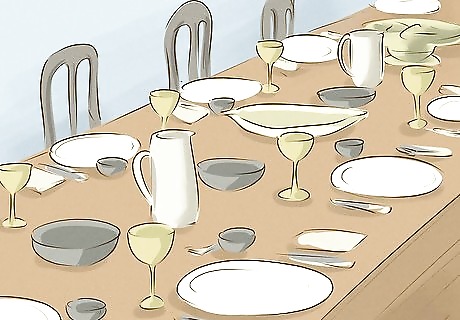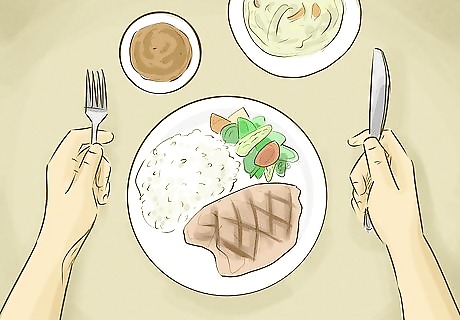
views
Studying Judaism

Read central Jewish texts. The primary sacred text of Judaism is the Tanach (also known as the Jewish Bible). This document is composed of three parts: the Pentateuch (Torah), the Prophets (Nevi'im) and the Writings (Ketuvim). Other sacred Jewish books include the Mishnah, Talmud, and Midrash. Find a Jewish study group or private tutor to guide you through these ancient texts.

Engage in a period of Jewish study. Whether you are converting to Judaism or simply looking to deepen your practice, a period of study can educate you and connect you to the faith. Many synagogues and Jewish centers offer classes. For some Jewish communities, taking a course like this is required before you can seek conversion to the faith. Classes can last anywhere from 14 weeks to 1 year. Look for a rabbi who will sponsor you and guide you in your journey.

Learn about the five main denominations of Judaism. Learn a bit about each of the five major Jewish traditions. This can help you determine where you would like to fit and better understand the Jewish faith. These are: Hasidic - This denomination is very strict and conservative, embodying the religion in every aspect of life. Hasids also incorporate Jewish mysticism into their teachings. Orthodox - Orthodox Judaism has several sub-denominations, the most common being Modern Orthodox. In general, Orthodox Jews stringently adhere to all laws and customs of the religion, while Modern Orthodox Jews typically try to balance a secular lifestyle with that as well. Conservative - Conservative Jews are generally more lenient in observance than Orthodox Jews, but conservatives are adherent to the basic values and tradition of the religion. Reform - This denomination is quite lenient in observance, though aware of the basic values and traditions of Judaism. Reconstructionist - This denomination is also very lenient in observance. They practice a mostly secular lifestyle.

Study the basics of Hebrew. Even a very limited grasp of Hebrew can deepen your understanding of the Jewish faith. If you can handle some Hebrew pronunciation, you can participate more fully in the synagogue. If you understand some key words, you can better understand the prayers. Take a class, or seek a Hebrew tutor. Ask a rabbi for advice on how to best study basic Hebrew.

Read about Jewish history. Learning about the history of Jewish people is an excellent way to connect with your Judaism. Historical knowledge can deepen your connection to Jewish people, and make you a more intelligent conversationalist in the Jewish community. Some books on Jewish history include: Border Lines by Daniel Boyarin. Between Muslim and Jew by Steven Wasserstrom. The Compunctious Poet by Ross Brann. Two Nations in Your Womb by Israel Jacob Yuval. Founder of Hasidism by Murray Jay Rosman.

Visit a Jewish museum. Visiting a museum can foster feelings of inspiration, connection, and empathy. Experiencing Jewish history, art, and culture through the lens of a museum can deepen your experience of Judaism. You might visit: The Jewish Museum in Berlin. Museum of Jewish Heritage in New York City. The Holocaust Museum in Washington D.C. Jewish Children’s Museum in Brooklyn. The Contemporary Jewish Museum in San Francisco.
Engaging with Jewish Culture

Do good deeds. The act of doing good deeds for others (also called mitzvah) is central to the Jewish faith. Look for opportunities to volunteer in your area, or come up with other ways to be of service. Ideas include: Bringing a meal to an elderly neighbor. Offering to watch your friend’s children when they cannot. Bringing food to your local food pantry. Donating money to charitable organizations.

Eat traditionally Jewish foods. Following a strict kosher diet might be more work than you want to do, but you can still connect more deeply with your Jewish practice by enjoying popular Jewish foods. Some choices include: Matzoh ball soup. Challah bread. Kugel. Potato latkes. Jelly-filled sufganiyot. Rugelach.

Read books with Jewish characters and themes. Literature has long been a window into the lives of others. Try reading stories that feature Jewish people and discuss Jewish ideas. Some recent examples include: The Laws of Gravity by Liz Rosenberg. Kaaterskill Falls by Allegra Goodman. The Golem and the Jinni by Helene Wecker. Herzog by Saul Bellow. The Innocents by Francesca Segal.
Participating in a Jewish Community

Attend synagogue. Synagogues are Jewish community centers used for worship, study, and celebration. Find a synagogue that matches your denomination and level of observance. Begin attending synagogue weekly, and participate as much as you can. If you have questions about the service, make an appointment to consult with a rabbi. Services are commonly held on Shabbat eve (Friday night), Shabbat morning (Saturday morning), and late Shabbat afternoon (Saturday afternoon). You might also attend services on Jewish holidays, such as Yom Kippur. This is an important way to get to know your local community and to learn more about Jewish traditions.

Attend a local Shabbat dinner. Shabbat is a traditional gathering that occurs at sundown on Friday nights. Look for a Shabbat dinner in your area that is open to all. This is an excellent way to meet other people in the Jewish community and to engage with an ancient custom.

Celebrate Jewish holidays. Some of the Jewish holidays include Rosh Hashanah (the Jewish New Year), Yom Kippur (the Day of Atonement), Sukkot, Simchat Torah, Hanukkah, Tu B'Shevat, Purim, Lag b'Omer, Shavuot, Tisha B'Av, and Rosh Chodesh. Seek opportunities to celebrate these holidays with your community.

Learn common Yiddish phrases if you are Ashkenazi Jewish. Learning the entire Hebrew language might be a bit too much work, but if you are of Ashkenazi descent, learning some commonly used Yiddish phrases can help you to better communicate with other Jews, and to feel more connected to Judaism. Some basic examples include: Kvetch - to complain. Mazel Tov - good luck. Oy vey - an exclamation of dismay. Shlemiel - a clumsy person.
Following the Rules of Orthodox Judaism

Keep the Sabbath. Orthodox Judaism is the strictest denomination. If you are seeking a strict and devoted religious practice, you may want to follow Orthodox guidelines. Orthodox Jews are called Shomer Shabbat, or keepers of the Sabbath. During the Sabbath, Orthodox Jews are not allowed to work, travel, carry money, discuss business, use electricity, light a fire, and make/receive phone calls. This time is cherished for its relaxing, spiritual separation from the busy workweek. The Sabbath starts at sundown every Friday and ends when there are three stars in the sky on Saturday night. Other non-Orthodox denominations follow the rules of the Sabbath to varying degrees.

Follow the dietary laws of Kashrut. Part of participating in an Orthodox Jewish lifestyle means adhering to a kosher diet. There are a several basic guidelines to follow. For items that come in wrappers or containers, make sure they have the hechsher symbol (most commonly are seen as a U inside a circle or a K, but can be other symbols) Do not eat shellfish or fish that don’t have scales Do not eat pig meat or the meat of any other animal without split hooves that does not chew its cud. Do not eat dairy and meat together.

Get circumcised. If you are converting to Orthodox Judaism, and you are male, you may need to be circumcised (also called brit milah). If you’ve already been circumcised, you may undergo a ritual called hatafat dam brit, which involves the drawing a small amount of symbolic blood.

Seek approval from a rabbinic court (or beit din). To officially convert to Orthodox Judaism, you will need the approval of a three person rabbinic court, or beit din. This court has the authority to decide whether or not you are ready for conversion. They will evaluate your knowledge, motivation, and intent to live the Jewish faith. In most instances, you must promise to accept of the yoke of the commandments (or kabbalat ol ha-mitzvot).

Immerse in a ritual bath (or mikveh). Once you gain the approval of the rabbinic court, the conversion is completed by immersing in a ritual bath. Usually this is a special pool (called a mikveh), but less conservative sects may allow the use of the ocean or a swimming pool.

Take a Hebrew name. After you are welcomed into the faith, you will take on a Hebrew name. Additionally, some Jewish documents may require to list your family connection to Judaism. In these cases, you might list your father as Abraham and your mother as Sarah.

















Comments
0 comment